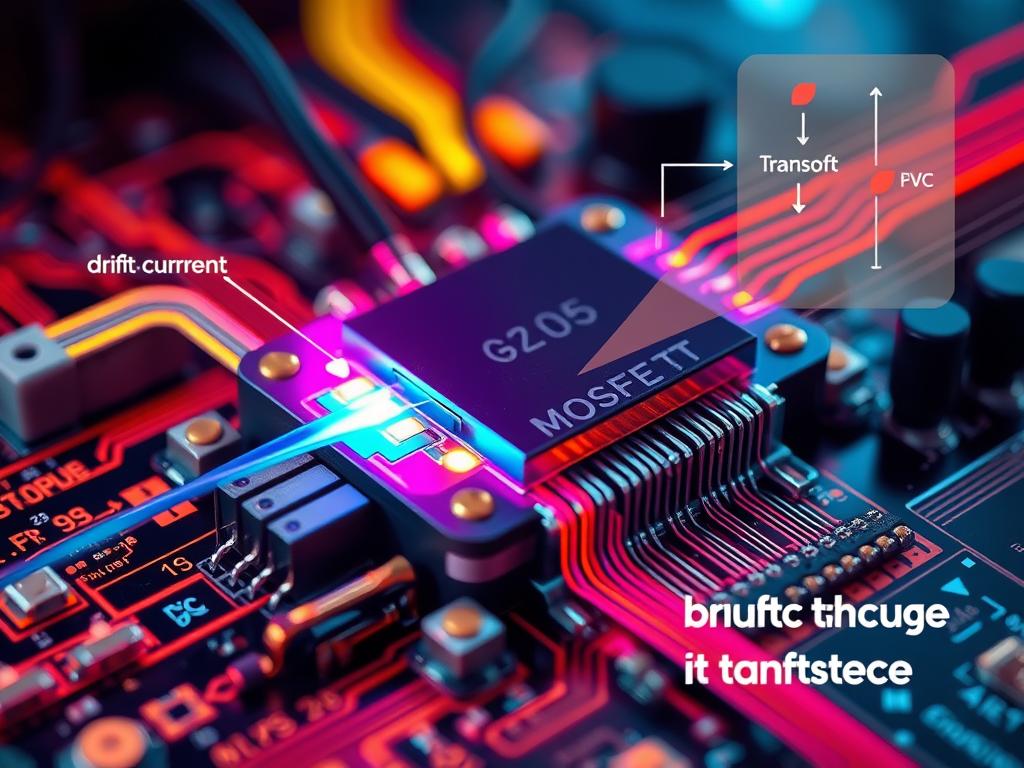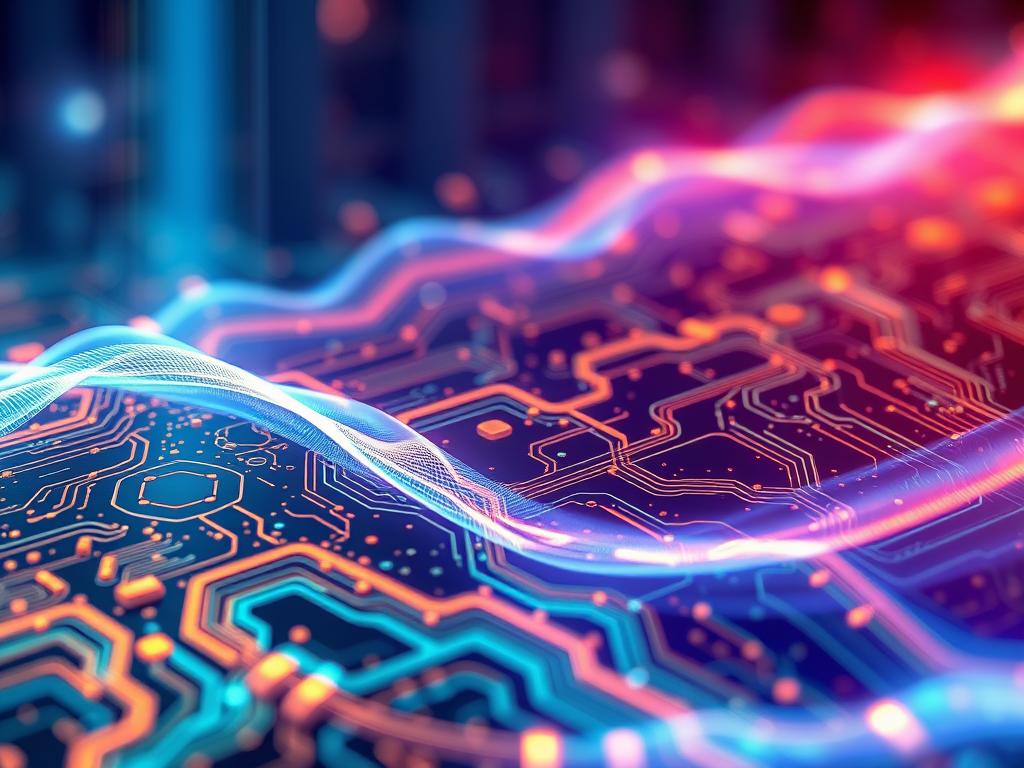Transistor shrinkage demands new drain current models. The University of Pisa leads research with Glasgow and Bologna universities. These models predict ultrashort channel transistor performance where old methods fail.
MOSFET modeling is shifting from drift-diffusion to ballistic transport approaches. This change is crucial for nanoscale transistors. It’s reshaping semiconductor design for devices as small as 22 nm.
Advanced models help understand how strain and high-κ dielectrics boost tiny transistors. Researchers use Monte Carlo simulations and Green’s Function simulators. These tools capture complex electron behavior in nanoscale devices.
This shift is accelerating the future of electronics. It pushes us beyond Moore’s Law limits. Accurate drain current models are vital for next-gen electronic devices.
The challenge is applying these models to cutting-edge semiconductor design. They’re not just theory—they’re the foundation of future electronics. Bridging this gap is key to advancing technology.
Understanding Drain Current in Transistors
Drain current is key to transistor operation. It affects device performance and power use. Let’s explore how drain current impacts electronic devices in MOSFETs.
What is Drain Current?
Drain current is the flow of charge carriers in a MOSFET. It moves from the source to the drain. This current is vital for transistor operation in electronic circuits.
Role in Electronic Devices
MOSFET drain current shapes electronic device performance. It affects speed, power use, and efficiency. The current-voltage traits show a transistor’s operating modes:
- Linear mode: Transistor acts as a voltage-controlled resistor
- Saturation mode: Channel narrows gradually on the drain side
Measuring Drain Current
Precise drain current measurement is crucial. It helps predict device behavior and improve circuit design. Engineers use various methods to check drain current:
- Current-voltage (I-V) characterization
- Pulsed measurements

Transistor size and drain current have a complex link. Larger transistors often allow more current flow. But there’s a limit where bigger size may reduce current.
| Transistor Size | Drain Current Behavior |
|---|---|
| 3μm x 3μm | Closely matches predicted theory |
| 15μm x 3μm | Deviates from predicted current |
| 20μm x 3μm | Significant deviation, may require passives |
Grasping drain current is vital for better transistor use. It helps in high-speed computing and energy-saving devices. This knowledge improves various electronic applications.
Key Drain Current Models: An Overview
Drain current models are vital for understanding transistor behavior. They range from simple to complex, each with unique strengths. These models help engineers and researchers analyze transistor performance effectively.
Drift-Diffusion Model Explained
The drift-diffusion model is a basic approach to understanding drain current. It assumes collision-dominated transport, making it ideal for longer channel devices. This model forms the basis for many semiconductor calculations.
Industry-standard compact MOS models like BSIM 4.6, PSP, and EKV use this approach. It’s widely used due to its simplicity and effectiveness in certain applications.

Boltzmann and Quantum Models
The Boltzmann transport equation (BTE) is used for shorter channel devices. It handles non-equilibrium transport, offering more accuracy in nanoscale transistors. This model is crucial for modern, smaller transistors.
Quantum transport models account for quantum confinement and tunneling effects. The Non-Equilibrium Green’s Function (NEGF) is an example of such a model. These are used for ultrashort channel devices, where quantum effects are significant.
Comparison of Drain Current Models
Let’s compare these models:
| Model | Accuracy | Computational Complexity | Applicability |
|---|---|---|---|
| Drift-Diffusion | Moderate | Low | Longer channels |
| Boltzmann | High | Moderate | Shorter channels |
| Quantum | Very High | High | Ultrashort channels |
Each model balances accuracy and computational complexity differently. The choice depends on the specific device and application needs. As transistors shrink, more advanced models become necessary.
These models capture the complex physics at play in modern transistors. They help engineers design and optimize new semiconductor devices effectively.
Ballistic Transport: A Game-Changer
Ballistic transport is changing semiconductor devices. Electrons move through materials without scattering, making devices faster and more efficient. This is crucial for nanoscale transistors with short channels.
Principles of Ballistic Transport
In ballistic MOSFETs, electrons travel collision-free from source to drain. This leads to higher carrier velocities and better device performance. Quantum ballistic transport models use the Landauer formula for accurate predictions.
These models outperform traditional diffusion-based ones for nanoscale devices. They provide more precise drain current calculations.
Advantages Over Diffusion Models
Ballistic transport offers several benefits over conventional diffusion models:
- Higher carrier velocities
- Improved device performance
- More accurate current predictions
- Better scalability for nanoscale devices
Applications in Cutting-Edge Technology
Ballistic transport powers various cutting-edge technologies. Nanowire transistors use this phenomenon to achieve superior performance. Recent studies have demonstrated ballistic superconductivity in indium antimonide semiconductor.
This discovery opens up possibilities for topological superconductivity. It also paves the way for Majorana modes in nanowire devices.
| Property | Silicon | Carbon Nanotubes |
|---|---|---|
| Carrier Mobility (cm2/(V·s)) | ~1,400 | Up to 100,000 |
| Saturation Velocity (cm/s) | 1 × 10^7 | 4 × 10^7 |
| Photoresponsivity at 590 nm (A/W) | N/A | 2842 |
| Response Time (ms) | N/A | 7.39 |
Ballistic transport advances are driving the future of electronics. These breakthroughs promise incredibly fast and efficient next-generation devices.
Practical Applications of Drain Current Models
Drain current models are vital in modern semiconductor device design. They help engineers predict and optimize transistor performance. These models lead to advancements in various fields.
Impact on Semiconductor Design
Advanced drain current models enable precise predictions of transistor behavior. This accuracy is crucial for creating energy-efficient transistors and improving device performance. Engineers use these models to explore new architectures and enhance transistor scaling.
Role in High-Performance Computing
High-performance computing depends on optimized transistor designs. Drain current models help fine-tune transistor parameters for faster, efficient processors. These models are key to developing cutting-edge technologies in data centers and supercomputers.
Influence on Energy Efficiency Standards
Energy-efficient transistors are essential for meeting modern power consumption standards. Drain current models help designers reduce power loss and boost device efficiency. This is crucial for battery-powered devices and large-scale computing systems.
| Application | Impact of Drain Current Models |
|---|---|
| Magnetic Sensors | Improved sensitivity in low-to-moderate magnetic fields |
| MOSFETs | Enhanced magnetoresistance effect in devices with W/L > 5 |
| Semiconductor Analysis | Precise measurements using advanced tools like Agilent B1500A |
Recent studies show practical applications of these models in magnetic field detection. Research on MOSFETs as magnetic sensors revealed interesting findings. A 100 mA loop current can generate a magnetic field of 1.385 mT.
“The integration of advanced drain current models in semiconductor design is revolutionizing the way we approach energy efficiency and performance in electronic devices.”
The demand for powerful, efficient devices keeps growing. Accurate drain current models are becoming more important in semiconductor design. Their role in high-performance computing and energy efficiency standards will continue to expand.
Challenges and Future Directions
Advanced drain current models face challenges in balancing precision and speed. Compact modeling must capture physical phenomena in ultrashort channel devices efficiently. This balance is vital for semiconductor technology’s progress.
Current models struggle with quantum effects in nanoscale devices. For example, dry oxidation yields a 0.82 nm oxide layer for (100) silicon. These atomic-scale phenomena become crucial as devices shrink further.
Limitations of Current Models
Drain current models can’t fully account for quantum effects in tiny devices. They struggle with ballistic transport in nanoscale transistors. Traditional approaches are pushed to their limits as devices get smaller.
Innovations in Modelling Techniques
Researchers are exploring new modeling techniques to overcome these limits. Multi-scale simulations combine atomistic and continuum models for better results. Compact modeling is evolving to meet the demands of modern devices.
Cylindrical Surrounding Double-Gate (CSDG) MOSFET models use concentric cylindrical geometry. These models aim to reduce short channel effects. They also help optimize device performance in advanced transistors.
Predictions for Future Research
AI-assisted device modeling is set to revolutionize the field. Machine learning will boost model accuracy and speed. This will lead to more efficient design processes for future devices.
Research will likely focus on modeling emerging device concepts. This includes 2D material-based transistors and quantum computing devices. These areas will open new frontiers in microelectronics research and development.


